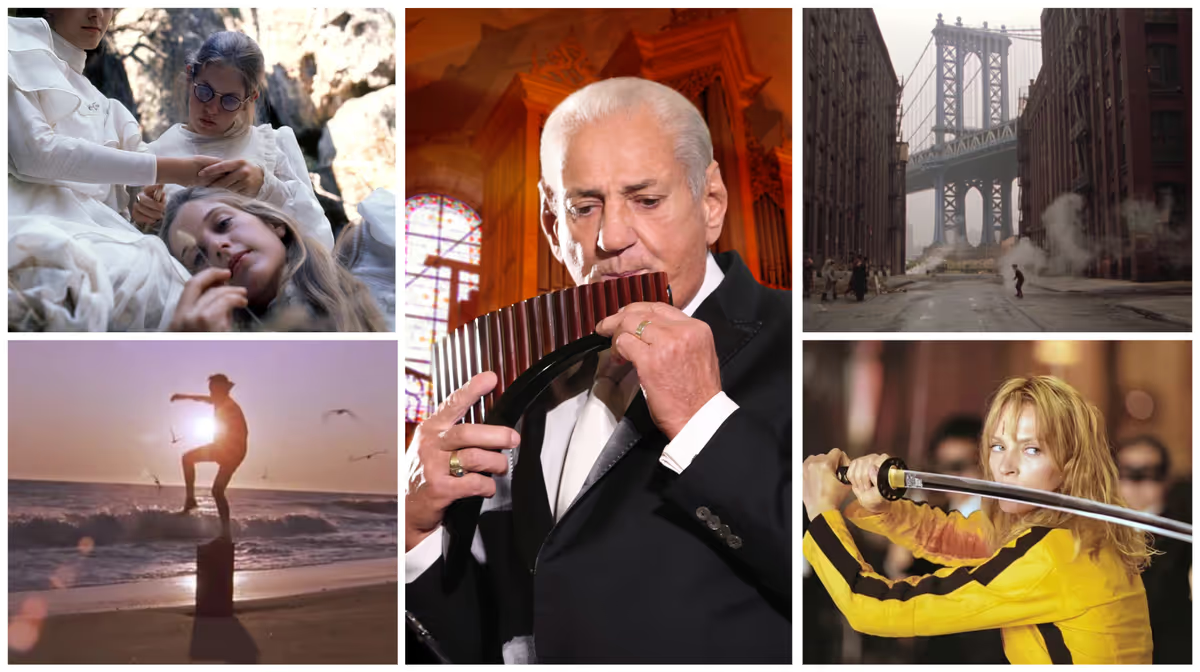An Interview with Gheorghe Zamfir, Master of the Pan Flute and Film Soundtrack Hero
The famed Romanian musician discusses his contributions to the world of film.

"This is the way," laughed the great god Pan
(Laughed while he sat by the river),
"The only way, since gods began
To make sweet music, they could succeed."
Then, dropping his mouth to a hole in the reed,
He blew in power by the river.
— from “A Musical Instrument,” Elizabeth Barrett Browning
Anyone who spent time watching American television in off-peak hours for stretches of the 1980s and ‘90s likely has a handful of commercials burned forever in their memory. Few made impressions as deep as those for music collections that offered a few tantalizing seconds of songs as a rolling tracklist for the full collection rolled in the background. Most were for familiar names. But one commercial more or less introduced a name to viewers in the United States: Zamfir, Master of the Pan Flute.
Zamfir, viewers were told, had “sold more than 20 million records around the world” and now they, too, could enjoy his work via the two-disc collection Zamfir Plays the World’s Most Beautiful Melodies. The spots alternated between dreamy stock footage and images of Zamfir in performance with his pan flute, “that magical instrument with the unforgettable sound.” “Relax,” the ad commands, “as Zamfir sweeps you away to a world of haunting, tranquil beauty.” Said world, we were to conclude, could best be accessed by way of pan flute-driven, easy listening music in which compositions by Mozart, Chopin played side-by-side with “Don’t Cry for Me Argentina” and “The Rose.”
The collection sold well — the ads ran forever and spawned a sequel — but they’re not fully representative of Zamfir’s larger contribution to the world of music and, especially for our purposes, film.
Consider this: If you’re watching a movie and Zamfir pops up on the soundtrack, you’re probably watching a pretty great movie, most likely a masterpiece of one kind or another, even if the films to which Zamfir made contributions have little in common. Picnic at Hanging Rock, The Karate Kid, Once Upon a Time in America, and Kill Bill, Vol. 1 would not be the movies we know without Zamfir and his pan flute. And it’s through a series of quirks of history that we even know about Zamfir at all.
Gheorghe Zamfir was born near Bucharest, Romania in 1941. His father enrolled him in a music school at the age of 14 where Zamfir planned to study the accordion. Unfortunately, the accordion class was canceled before Zamfir could begin his studies. Fortunately, he caught the attention of the Romani-Romanian Fănică Luca, Romania’s foremost nai, or pan flute, virtuoso.
The Reveal is a reader-supported newsletter dedicated to bringing you great essays, reviews and conversation about movies. While both free and paid subscriptions are available, please consider a paid subscription to support our long-term sustainability.
It’s impossible to tell the rest of Zamfir’s story without a digression about the pan flute. One of the world’s oldest instruments, it shows up in the art and literature of Ancient Greece and Rome (hence the association with Pan). But the pan flute’s origins go back further still, so far it’s hard to talk about a single origin. Variations on the pan flute, or panpipe, can be found across the globe (Zamfir was sometimes mistakenly referred to as Andean because of that region’s panpipe music) and seem to have developed independently of one another. The instrument’s simplicity helps explain this. In its most basic form, a pan flute is a series of pipes that play a single note bound together. Many cultures developed varieties of pan flutes and European pan flutes can be traced to Greece. These include the Romanian variation, the nai. The nai has had a centuries-old place in Romanian music, but waned in popularity in the 19th century.
It was the self-taught Luca who helped turn that around in the 20th century, first by taking pan flute music to the rest of Europe, the 1939 New York World’s Fair, China, Russia, and elsewhere. Luca also trained a new generation of pan flutists of which Gheorghe Zamfir became the most famous. Zamfir would become an even more high-profile ambassador via a series of concerts in Paris in 1970 that brought him to the attention of a much wider audience. Paris was also home to Vladimir Cosma, a prolific Romanian composer who’d been based in Paris since 1963. Sensing a chance to infuse his latest assignment, the Yves Robert-directed/Francis Veber co-scripted spy comedy Le Grand Blond Avec Une Chaussure Noire (The Tall Blond Man with One Black Shoe), with an unusual sound, Cosma recruited Zamfir for the project, beginning the pan flutist’s work in film.
I wanted to know more about Zamfir’s film work, so I reached out to his office. Zamfir, now 84, agreed to answer a series of questions via email. You’ll find that conversation below, accompanied by a history of Zamfir’s soundtrack contributions.
A big European hit in the 1970s (albeit one whose charms have not weathered the years well), later remade as the Tom Hanks-starring 1985 film The Man with One Red Shoe, The Tall Blond Man with One Black Shoe further raised Zamfir’s profile. He’d again collaborate with Cosma on the 1974 sequel, The Return of the Tall Blond Man with One Black Shoe. Cosma’s score makes good use of Zamfir as a quirky element in a bouncy score perfectly suited to a low-stakes comedy about a hapless violinist who’s unwittingly swept up in a tale of international intrigue. But it was Zamfir’s next high-profile assignment that would more fully explore the otherworldly qualities of the pan flute.
How did you first come to work with composer Vladimir Cosma? Did you come to his attention via the Paris concerts of 1970?
My collaboration with composer Vladimir Cosma began in 1972, when Cosma invited me to perform as the soloist for the film Le Grand Blond Avec Une Chaussure Noire. Before this, I had gained recognition in Romania and internationally, notably through my association with Swiss ethnomusicologist Marcel Cellier, who introduced me to Western audiences.
The 1970 Paris concerts were significant in my early exposure to Western audiences, but they were not the direct catalyst for my collaboration with Cosma. Instead, it was Cosma's specific interest in incorporating the pan flute into his film scores that led to our partnership.
The pan flute was not a standard element of a film score in the 1970s. How did your collaboration with Cosma work on The Tall Blonde Man with One Black Shoe come about?
Indeed, the pan flute was not a standard element of a film score in the 1970s. The instrument set a significant milestone in both mine and Cosma's careers, introducing the Romanian pan flute (nai) to a broader Western audience.
Cosma sought to create a distinctive sound for the film, avoiding the typical spy-movie style. He chose to feature the pan flute, played by me, alongside an Eastern European cymbalum, to evoke a sense of Romanian musical heritage. Director Yves Robert and producer Alain Poiré supported Cosma's vision.
My contributions included playing traditional Romanian themes, such as the sârba and doina, which became integral to the film's score. The unique blend of instruments and melodies ultimately contributed to the film's charm and success.
My performance, my interpretation style in particular, showcased the expressive potential of the pan flute in cinematic music, leading to further opportunities in film scoring and concert performances worldwide.
Zamfir isn’t solely responsible for the soundtrack of Picnic at Hanging Rock, but his two contributions to Peter Weir’s 1975 film help set the film’s haunting, unclassifiable tone. Both “Doina: Sus Pe Culmea Dealului” and “Doina Lui Petru Unc” adapt traditional Romanian folk melodies as duets for the pan flute and organ. What does this have to do with the story of a group of turn-of-the-century Australian schoolgirls disappearing during a school outing? On the face of it, nothing. But Weir’s film brilliantly recontextualizes music that had been largely confined to Romania just a few years later to serve a story in which time and space seem to bend in disorienting, disturbing ways. Though maybe “recontextualize” isn’t exactly the right word. Zamfir’s tracks have their origins in a particular tradition but here they sound like they might be melodies as old as Pangea, The sound of Zamfir helps sweep the girls away. Whether they enter a world of haunting, tranquil beauty, remains unanswered.
Did your work with Cosma lead to your contributions to Picnic at Hanging Rock?
Director Peter Weir chose existing recordings of my performances, particularly my renditions of traditional Romanian pieces and classical adaptations, especially “Doina: Sus Pe Culmea Dealului” and “Doina Lui Petru Unc” – traditional Romanian sorrow songs, played on the pan flute, which became the film’s signature musical motif. The pan flute, with its breathy and ancient tone, evokes a sense of timelessness and natural mysticism that aligns perfectly with Weir’s themes of nature, repression, and the unknown. Picnic at Hanging Rock became a classic of Australian cinema, and my music was often credited as a key part of my pan flute's hypnotic effect.
The music's success in the film led to its release on various albums, including A Theme from Picnic at Hanging Rock (1976), which featured the same compositions and instrumentation. This piece was originally released on recordings made in collaboration with Swiss ethnomusicologist Marcel Cellier, and has nothing in common with Cosma.
If I understand correctly, Picnic at Hanging Rock uses your versions of traditional Romanian folk songs paired with just an organ. It's haunting and one of my favorite uses of music in any movie. How did that arrangement come about?
The organ's sustained chords provided a grounding counterpoint to the pan flute's melodic lines, enhancing the film's dreamlike quality. This pairing of instruments, though not originally composed for the film, became iconic in its association with Picnic at Hanging Rock. These recordings have since become cherished examples of how traditional music can transcend cultural boundaries to evoke universal emotions .
Did you know what context your music would be used for?
Absolutely. Though there was no direct collaboration between Weir and me during production, this approach helped establish a new kind of sound in film scoring—sparse, non-orchestral, and globally reaching.
I hoped that the acceptance of using my music would help define the film’s signature emotional atmosphere, and my pan flute music would be exposed to a new and [broader] public.
A collaboration with German composer and bandleader James Last, best known for his work in the easy listening sphere, “The Lonely Shepherd” became a considerable hit in much of the world before being repurposed as theme music for several TV series. The song undoubtedly didn’t sound out of place on the softer ends of the radio dial in ‘70s Europe. It also sounds like it might have been written specifically for the scene in 2003’s Kill Bill, Vol. 1 scene in which The Bride (Uma Thurman) commissions then later receives a sword from master wordsmith (Hattori Hanzō), where it underscores the sense of shared hurt and the inevitability of their interaction. These two were always going to have this moment. “The Lonely Shepherd” gives it an understated grandeur.
You had an international hit with "The Lonely Shepherd." Did its second life in film and television surprise you? Did you like the way it was used in Kill Bill?
“The Lonely Shepherd” represents the aesthetic that I became known for: evocative, haunting, and spiritual music that transcends genres and cultures. It was not a surprise for me that Quentin Tarantino used “The Lonely Shepherd” in a powerful, atmospheric sequence near the end of Kill Bill, Vo1. 1. The song is a blend of Eastern European folk, classical, and cinematic ambient music, melancholic, mystical, reflective — with a sense of solitude and timelessness. Because of that, it became a cross-cultural anthem of introspection and power. It’s a perfect example of how music, especially pan flute music’s transcendent sound, can elevate a cinematic moment into something unforgettable.
By the early 1980s, Zamfir enjoyed tremendous success as a concert and recording artist almost everywhere except the U.S., despite having a strong following just to the north in Canada, where he purchased a home. That didn’t apparently diminish his appeal to the American film industry. Zamfir worked on the score of Robert Duvall’s now impossible-to-find Angelo, My Love and his playing can be heard throughout Bill Conti’s score for The Karate Kid (and its sequels), usually in scenes concerning Mr. Miyagi (Pat Morita).
1984 was a big year for your movie work. How did you come to work with Bill Conti on The Karate Kid score?
In The Karate Kid, I recorded new material specifically for the film with Conti. Conti's orchestral writing and my minimalist, expressive style created a deeply resonant and emotional score. The pan flute has ancient and cross-cultural connotations — it feels both Eastern and Western, ancient yet timeless.
Our collaboration stands as a beautiful example of how film scoring can merge classical orchestration with world music traditions to enhance storytelling.
Did Conti talk about why he wanted to use a pan flute?
Conti's decision to incorporate the pan flute was driven by his appreciation for the instrument's unique timbre, aiming to evoke an 'ethereal quality' that aligns with the film's themes of wisdom and mentorship.
Zamfir’s film work included a remarkable contribution to Ennio Morricone’s score to Sergio Leone’s swan song, Once Upon a Time in America, also released in 1984. Morricone experimented with new sounds and textures throughout his career. It seems a fortunate coincidence that his work on Leone’s mournful gangster epic coincided with the peak of Zamfir’s work on movie scores. Leone had composed the music years earlier in the 1970s as Leone struggled to get the film made. The elegiac “Cockeye’s Theme” would undoubtedly work with another instrument at the fore, yet Zamfir’s almost seems to have been summoned by the sense of loss at the heart of the film. Zamfir’s film contributions would become less frequent in the years that followed, even as his name became more familiar to American viewers.
Once Upon a Time in America was also released that year. What was your collaboration with Ennio Morricone like?
In 1983 ,I was invited by Ennio Morricone and director Sergio Leone to contribute to the film's score. Reflecting on this experience in my autobiography, Binecuvântare și blestem [Blessing and Curses —ed.], I described it as "unique," noting that the pan flute's inclusion had a significant impact on the film's emotional depth. My distinctive pan flute performance added a haunting and evocative quality to the film's music, particularly in the tracks “Cockeye's Song,” one of the most famous pieces in the score, and “Childhood Memories.”
I believe Morricone wrote the score for the film years earlier. Did he always have you and the pan flute in mind or did you come in later?
The pan flute wasn't Morricone’s choice. The script writer wanted to have someone play that instrument... Morricone called me because he knew that I was a good performer on the instrument. One of the most famous pieces in the score, my version of “Amapola” that was featured on my 1985 album Atlantis, also gained audience through its inclusion in the 1984 film Once Upon a Time in America, directed by Sergio Leone, where it was arranged by Ennio Morricone.
You’ve contributed less often to films after the 1980s. Was that a conscious choice? Did your recording and performing career limit your time?
After 1980, I toured extensively around the world and was heavily involved in recording new albums. I dedicated myself to developing the instrument andintroducing it to new musical styles, because its potential was not being fully exploited.
Beyond my performance, I have contributed to music education through my instructional book Traité Du Naï Roumain: méthode de flûte de pan, fostering a new generation of pan flute musicians which are spread all over the world.
Are there any movie scores with pan flutes you like other than those to which you contributed?
I have not come into contact with the music of another composer who uses the pan flute in movies apart from Elia Cmiral [whose work includes scores for Ronin and Wrong Turn, among many other films. —ed.], a Hollywood composer, with whom I have had a very beautiful collaboration since 2018. With Elia, I recorded the soundtrack for the short film “Lacrimosa,” very awarded, and he composed, especially for me, a masterpiece for the pan flute, named Two Suites for Pan flute and Orchestra (Six Stories from an Enchanted Garden and Sinfonia Concertante for Pan Flute and Orchestra), available now on digital platforms and as a physical CD.
What would your advice be to filmmakers who wanted to use the pan flute in their movies?
I recommend that filmmakers use the divine sound of the Pan Flute to highlight the depth of landscapes, evoke positive emotions, and convey deep feelings. Feelings like love, passion, admiration, contemplation, and introspection can be easily evoked with a Pan Flute sound background. There is not a drop of negativity in the Pan Flute sound.




Discussion